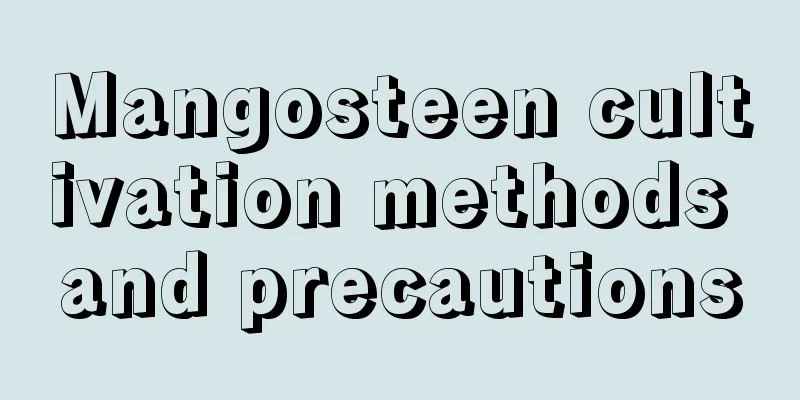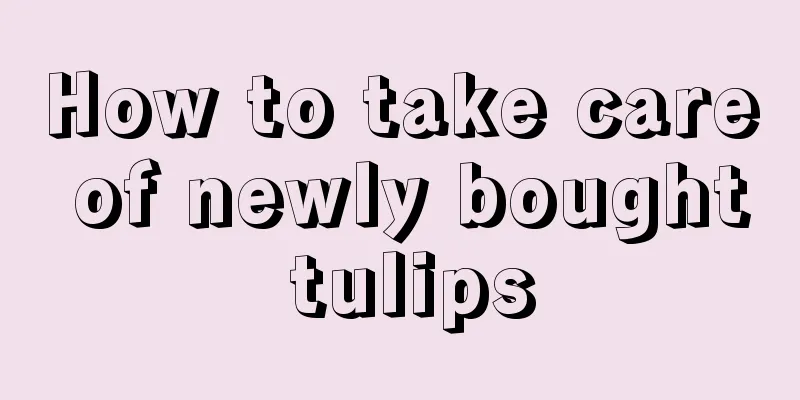Mangosteen cultivation methods and precautions

1. Maintenance methods1. Temperature: Mangosteen prefers slightly higher temperatures. Specifically, it grows most vigorously between 25 and 35 degrees. If the temperature is around 20 degrees, it can basically meet the conditions for its growth. In summer, the temperature should not exceed 35 degrees. In winter, the temperature must not be lower than five degrees, otherwise you will easily get cold. 2. Watering: During the growth period of mangosteen, it needs more water. However, even during the growth period, it is best not to allow water to accumulate. In winter, you should not completely stop watering the plants. When the temperature is suitable, you also need to replenish water in time. 3. Light: Mangosteen prefers weak light, strong light is not suitable for it. Specifically, the degree of shading is preferably between 40 and 75 percent. Of course, it can also be placed directly in a semi-shaded position. 4. Soil: Its requirements for soil are reflected in nutrition, drainage and pH. It is better to choose fertile, well-drained and slightly acidic soil. 2. Breeding techniques1. Reproduction: It can be propagated by cuttings. You can cut a strong branch about eight to ten centimeters long, and then. Then, sandy soil can be used as the substrate. After the wounds on the branches have dried, you can start cuttings. After cutting, water it lightly and place it in a cool place. 2. Repotting: Since it has certain requirements for the soil, it is best to repot it regularly. It can be once every two years or once every three years. If the soil quality is poor and the clumping phenomenon is very serious, it can be replaced in time. The flower pots can also be replaced. Pruning can also be done in conjunction with repotting. 3. Problem diagnosis and treatment1. Diseases: Mangosteen has relatively few diseases. Occasionally, diseases that damage the leaves may occur, such as "leaf blight". Generally speaking, spraying the medicine two or three times will be enough to cure it. 2. Pests: Compared with diseases, pests are more likely to appear. For example, mealybugs will threaten the tenderer leaves. It can be prevented by using aphid-repelling mist. There are also "thrips" and other insects, which can be sprayed with dichlorvos. IV. Other issues1. Toxicity: The mangosteen plant is not poisonous and its fruit is edible. The core of the fruit is also non-toxic. 2. Can it be grown at home: Its potted plants can be grown at home. When the fruit is ripe, it is quite ornamental. |
<<: Cycad cultivation methods and precautions
>>: Green treasure tree cultivation methods and precautions
Recommend
How to plant Lipu taro
The Lipu taro is shaped like an olive, with a rou...
Iris transplantation method
Preparation The main preparations for growing iri...
What to do if the leaves of the hanging bamboo plum become soft
Symptoms of limp leaves: The leaves feel soft and...
Cultivation methods and precautions of red cicada flower
Living habits First of all, because the plant is ...
The functions of the fortune tree
The ornamental value of the fortune tree The mone...
The reason why the tips of camellia leaves turn black and fall off
1. Low temperature Reason: Camellia prefers a war...
How long does it take for purple bamboo plum to take root after cuttings, and what kind of soil should be used
1. Cutting method When cutting purple bamboo plum...
If you grow lucky bamboo like this, its leaves will be green and lush, and everyone will praise it when you put it in your living room!
Plants like lucky bamboo are good. Firstly, the n...
Top 10 famous brands of compound fertilizers in China (which brand of compound fertilizers has good quality)
What brand of compound fertilizer is good in Chin...
When is the best time to plant tea seedlings? What is the best month to plant?
It is best to choose two-year-old seedlings for p...
Causes and treatments for yellow leaves of Chlorophytum comosum
1. Excessive fertilization 1. Reason: Fertilizing...
How to propagate violet spider plant and what to pay attention to
How to propagate violet spider plant There are fo...
How to grow succulent peach to a jelly color
Succulent peach growing conditions The peach tree...
Potato planting time and method planting method steps
Potato planting time The planting time for potato...
Does green radish need fertilizer in winter?
1. Whether to apply fertilizer The temperature wi...









